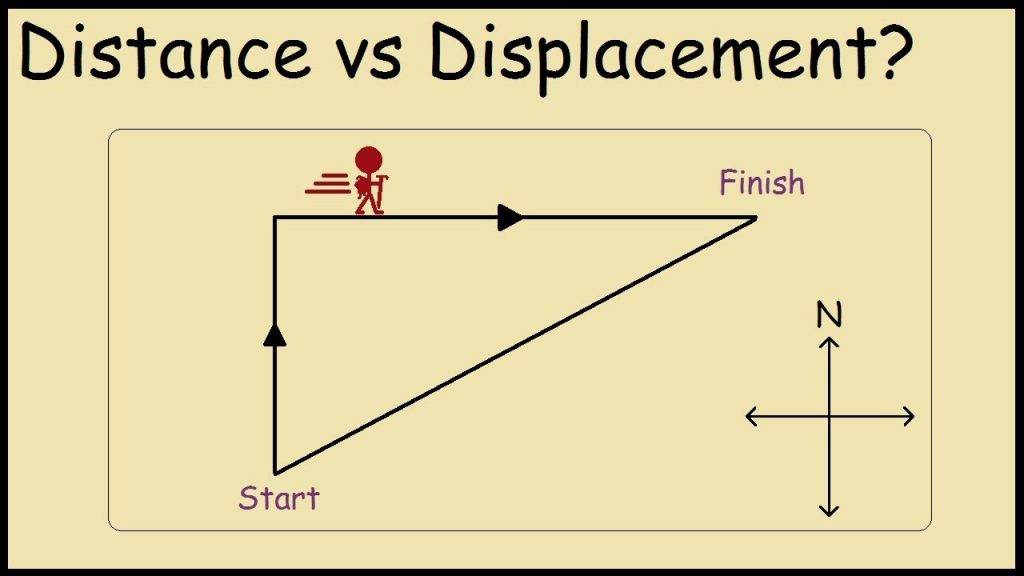A commonly asked tricky and confusing question in physics is the difference between distance and displacement. In this article, we will provide the full details about Distance and Displacement Explained With Formula.
A thorough study of distance and displacement is required to understand the differences. This is a question that has become common in examinations.
So, let’s look at the different formulas of distance and displacement.
Formula
| Sl. No. | Differentiating Property | Distance | Displacement |
| 1 | Definition | The length from one point to another point is known as Distance. | The direct length between two points if measurement is taken along the minimum path is called displacement. |
| 2 | Denotation | d | s |
| 3 | Direction Consideration | For distance calculation, the direction is not considered. | For displacement calculation, the direction is taken into consideration. |
| 4 | Quantity | It is a scalar quantity, and it doesn’t depend on direction but only magnitude. | It is a vector quantity, and it depends upon magnitude and direction. |
| 5 | Route Information | It gives route information in detail while going from one point to the other. | Displacement is the shortest path and does not give complete information on the route. |
| 6 | Formula | Speed x Time | Velocity x Time |
| 7 | Possible Values | Distance gives out positive values. | Displacement gives out positive, negative as well as zero. |
| 8 | Indication | Arrow is not an indication of Distance. | Arrow is an indication of Displacement. |
| 9 | Measurement in Non-Straight Path | The measurement of distance can take place in a non-straight path. | The measurement of displacement can be taken in a straight path. |
| 10 | Path Dependence | Distance is as per the path, i.e., there is a change according to the path taken. | Displacement does not depend upon the path and depends on the initial and final position of the body. |
Important Facts About Distance
- While in motion, a body covers a total path from one point to another point. The length of the path taken by the body is Distance.
- The S.I unit of distance is meter.
- The formula for Distance is Speed x Time.
- It is a scalar quantity and path-dependent.
- Distance between two points is always positive and is symmetric.
Important Facts About Displacement
- While in motion, a body covers the shortest path from one point to another point. The length of the shortest path taken by the body is Displacement.
- The S.I unit of displacement is meter.
- The formula for Displacement is Velocity x Time.
- It is a vector quantity and path-independent.
- The displacement between two points can be positive, negative and zero and is anti-symmetric.
Examples of Distance and Displacement
Example 1:
A runner begins to run for 100 meters on a straight line from a start line to complete a race. The distance travelled, and displacement of the runner can be calculated. The runner runs on a straight path in a single direction. The distance and the displacement of the runner will be similar and equal to 100 meters.
Example 2:
- When a satellite revolves around the earth, the distance covered by it would be equal to the circumference of the earth. The radius of the earth is 6371 kms, and hence its circumference will be = 2πr
= 2 x π x 6371 kms
= 2 x 3.14 x 6371 kms
= 40,009.88 kms
To convert from km/hr to m/s, it can be multiplied by 5/18. So, the distance will be 11,113.85 m.
The satellite returns to its initial point where it started, so its displacement will be zero.
- If a satellite takes one and a half revolutions, what will be the distance travelled and displacement of the satellite? The distance travelled of the satellite will be-
= 2πr 2πr/2
= 40,009.88 40,009.88/2
= 40,009.88 20,004.94
= 60,014.82 kms
After it is converted to meters, it becomes 16,670.78 m.
Now, the satellite is diametrically opposite to earth; hence the diameter of earth and displacement will be equal.
Displacement = 2 x radius of earth
= 2 x 6371 kms
= 12,742 kms
12,742 km is converted into meters and becomes 3539.44 m.
Example 3:
A car moves at a speed of 30 km/hr for 2 hours on a straight road. Calculation of distance travelled, and displacement will be as under –
Distance = Speed x Time
The car will have travelled a distance of 30 km/hr x 2 hrs = 60 km
The car travels in a linear direction so that the displacement will be equal to the distance travelled. The displacement of the car is 60 km. After it is converted, the displacement becomes 16.66 m.
Formula
Explanation of the formulas of distance and displacement will be as under for a better grasp of the concept. Distance and Time are fundamental quantities of measurement. The relation of distance, speed as well as time has to be comprehended. The distance of an object is calculated by the formula – Distance = Speed x Time.
Example 1:
How to calculate the distance of a golf cart if it is driven at a top speed of 27 km/hr for 10 minutes? The distance of the golf cart has to be in meters. There is a need to change the units of time and speed.
s = 27 km/hr
s = 27 km/hr x 1000 m/1 km x 1 hr/60 minutes x 1 min/60 sec
= 7.5 m/sec
After the conversion of units, speed is 7.5 m/sec.
t = 10 min
t = 10 min x 60 s/1 min
= 600 sec
The speed of the golf cart and the time of travel are given, and now the distance travelled can be found.
distance = speed x time
= 7.5 m/s x 600 s
= 4500 m
The distance travelled by the golf cart is 4500 m.
Example 2:
From a post office, a postman travels to a village to distribute mail. He rode on a bicycle from the post office at a speed of 25 km/hr. While he was returning, his bicycle got stolen. So, at the speed of 4 km/hr, he walked back to the post office on foot. If the travelling part of his day lasted for 2 hours and 54 minutes, what is the distance between the post office and the village?
Let time taken by postman to travel from post office to village = t minutes
As per the situation, distance from post office to village, say d1 = 25/60 x t km (25 km/hr = 25/60 km/minutes)
Distance from village to post office, say d2 = 4/60 x (174-t) km (2 hours 54 minutes = 174 minutes)
Since distance between village and post office will always remain same i.e., d1=d2
= > 25/60 x t = 4/60 x (174-t) = > t = 24 minutes
Distance between post office and village = speed x time = 25/60 x 24 = 10 km.
After it is converted to meters, it becomes 2.77 m.
The formula of distance and displacement is an interesting concept, and in reality, they are two different things. Displacement is used as an alternative to distance. For example,
- A cyclist starts on a circular track from one point to another and stops. What will be the displacement? It is assumed that the cyclist rides for 4 km and stops at point B. So, the displacement will be 2r that is 2.54 km. After it is converted, the displacement becomes 0.70 m.
Conclusion
Distance and Displacement are crucial in Physics. You can clearly understand the topics of speed and velocity when studied together with the formulas of distance and displacement. Displacement can be equal or less than the distance in numerical value, but never more than distance. Even solving a distance and displacement problem in physics makes a person keep on trying to get a solution to it. Differences between distance and displacement along with formulas of distance and displacement simplify equations.









